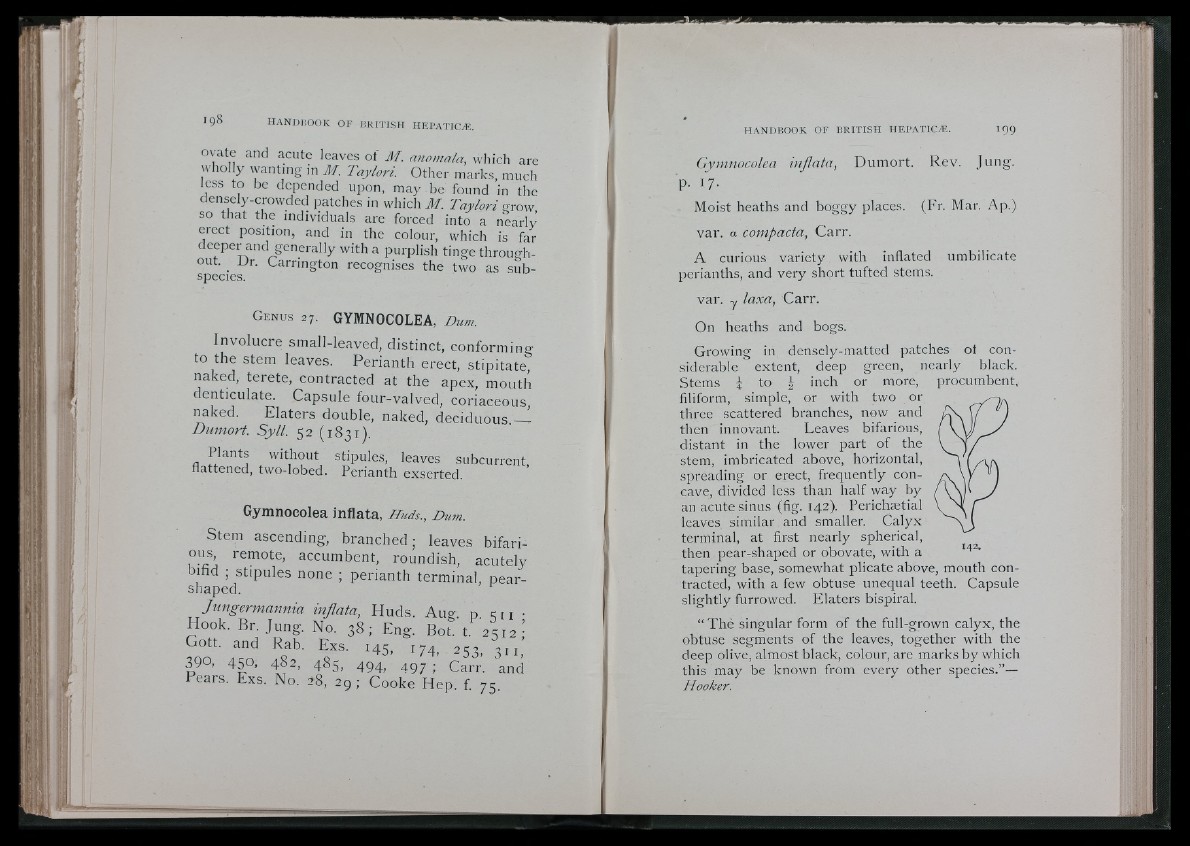
Ii')
t>
♦
f'
Vt
t
I
ovate and acute leaves of J\f. anomala, wliich are
wliol y wanting in M. Taylori. Otlicr marks, much
less to be depended upon, may be found in the
dcnscly-crowdcd patches in which M. Taylori grow
so that the individuals are forced into a nearlv
/ c c t position, and in the colour, which is far
dcepcr and generally with a purplish tinge throughout.
Ur. Carrington recognises the two as subspecies.
G e n u s 2 7 . GYMNOCOLEA, Dum.
Involuc re small-leaved, distinct, conforming
to the stem leaves. Per ianth erect, stipitate,
naked, terete, contracted at the apex, moutli
denticulate. Capsule four-valved, coriaceous
naked. Elaters double, naked, deciduous —
Dumort. Syll. 52 (1831 ) .
Plants without stipules, leaves subcurrcnt,
flattened, two-lobed. Perianth exserted.
Gymnocolea inflata, Huds., Dum.
Stem ascending, b ranched; leaves bifari-
oiis remote, accumbent, roundish, acutely
bihd ; st ipules none ; perianth terminal, pear-
shaped.
Jungermannia injlata, Huds . A u g . p 511 •
Hook. Br. Jung. No. 38 ; Eng. Bot. t. 2 5 12 , ’
Gott. and Rab. Exs. 145, 174^ 253, 3 1 1 ,
390, 450, 4 ^ ' 485, 4 9 4 , 4 9 7 ; Carr’, and
Pears. Exs. No. 28, 2 9 ; C o o k e Hep. f. 75.
Gymnocolea injlata, Dumort. Rev. Jung,
p. 17.
Moist heaths and boggy places. (Pr. Mar. Ap.)
var. a compacta, Carr.
A curious variety with inflated umbilicate
perianths, and very short tufted stems.
var. y laxa, Carr.
On heaths and bogs.
Growing in densely-matted patches ot considerable
extent, deep green, nearly black.
Stems i to ) inch or more, procumbent,
filiform, simple, or with two or
three scattered branches, now and
then innovant. Leaves bifarious,
distant in the lower part of the
stem, imbricated above, horizontal,
spreading or erect, frequently concave,
divided less than half way by
an acute sinus (fig. 142). Perichætial
leaves similar and smaller. Calyx
terminal, at first nearly spherical,
then pear-shaped or obovate, with a
142.
tapering base, somewhat plicate above, mouth contracted,
with a few obtuse unequal teeth. Capsule
slightly furrowed. Elaters bispiral.
“ Thé singular form of the full-grown calyx, the
obtuse segments of the leaves, together with the
deep olive, almost black, colour, are marks by which
this may be known from every other species.”—
Hooker.